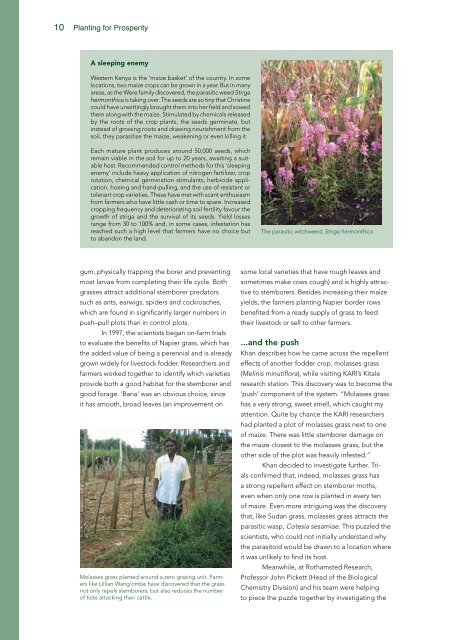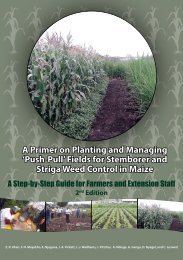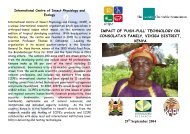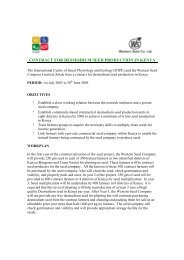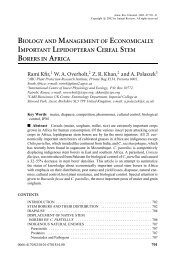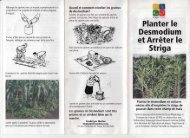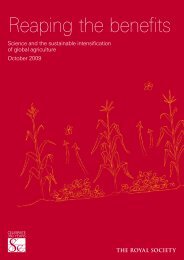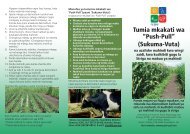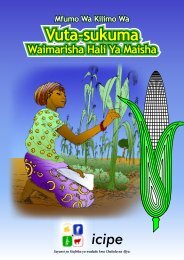a model for Africa's green revolution - Push-Pull
a model for Africa's green revolution - Push-Pull
a model for Africa's green revolution - Push-Pull
You also want an ePaper? Increase the reach of your titles
YUMPU automatically turns print PDFs into web optimized ePapers that Google loves.
10 Planting <strong>for</strong> Prosperity<br />
A sleeping enemy<br />
Western Kenya is the ‘maize basket’ of the country. In some<br />
locations, two maize crops can be grown in a year. But in many<br />
areas, as the Were family discovered, the parasitic weed Striga<br />
hermonthica is taking over. The seeds are so tiny that Christine<br />
could have unwittingly brought them into her field and sowed<br />
them along with the maize. Stimulated by chemicals released<br />
by the roots of the crop plants, the seeds germinate, but<br />
instead of growing roots and drawing nourishment from the<br />
soil, they parasitise the maize, weakening or even killing it.<br />
Each mature plant produces around 50,000 seeds, which<br />
remain viable in the soil <strong>for</strong> up to 20 years, awaiting a suitable<br />
host. Recommended control methods <strong>for</strong> this ‘sleeping<br />
enemy’ include heavy application of nitrogen fertilizer, crop<br />
rotation, chemical germination stimulants, herbicide application,<br />
hoeing and hand-pulling, and the use of resistant or<br />
tolerant crop varieties. These have met with scant enthusiasm<br />
from farmers who have little cash or time to spare. Increased<br />
cropping frequency and deteriorating soil fertility favour the<br />
growth of striga and the survival of its seeds. Yield losses<br />
range from 30 to 100% and, in some cases, infestation has<br />
reached such a high level that farmers have no choice but<br />
to abandon the land.<br />
The parasitic witchweed, Striga hermonthica<br />
gum, physically trapping the borer and preventing<br />
most larvae from completing their life cycle. Both<br />
grasses attract additional stemborer predators<br />
such as ants, earwigs, spiders and cockroaches,<br />
which are found in significantly larger numbers in<br />
push–pull plots than in control plots.<br />
In 1997, the scientists began on-farm trials<br />
to evaluate the benefits of Napier grass, which has<br />
the added value of being a perennial and is already<br />
grown widely <strong>for</strong> livestock fodder. Researchers and<br />
farmers worked together to identify which varieties<br />
provide both a good habitat <strong>for</strong> the stemborer and<br />
good <strong>for</strong>age. ‘Bana’ was an obvious choice, since<br />
it has smooth, broad leaves (an improvement on<br />
Molasses grass planted around a zero grazing unit. Farmers<br />
like Lillian Wang’ombe have discovered that the grass<br />
not only repels stemborers, but also reduces the number<br />
of ticks attacking their cattle.<br />
some local varieties that have rough leaves and<br />
sometimes make cows cough) and is highly attractive<br />
to stemborers. Besides increasing their maize<br />
yields, the farmers planting Napier border rows<br />
benefited from a ready supply of grass to feed<br />
their livestock or sell to other farmers.<br />
...and the push<br />
Khan describes how he came across the repellent<br />
effects of another fodder crop, molasses grass<br />
(Melinis minutiflora), while visiting KARI’s Kitale<br />
research station. This discovery was to become the<br />
‘push’ component of the system. “Molasses grass<br />
has a very strong, sweet smell, which caught my<br />
attention. Quite by chance the KARI researchers<br />
had planted a plot of molasses grass next to one<br />
of maize. There was little stemborer damage on<br />
the maize closest to the molasses grass, but the<br />
other side of the plot was heavily infested.”<br />
Khan decided to investigate further. Trials<br />
confirmed that, indeed, molasses grass has<br />
a strong repellent effect on stemborer moths,<br />
even when only one row is planted in every ten<br />
of maize. Even more intriguing was the discovery<br />
that, like Sudan grass, molasses grass attracts the<br />
parasitic wasp, Cotesia sesamiae. This puzzled the<br />
scientists, who could not initially understand why<br />
the parasitoid would be drawn to a location where<br />
it was unlikely to find its host.<br />
Meanwhile, at Rothamsted Research,<br />
Professor John Pickett (Head of the Biological<br />
Chemistry Division) and his team were helping<br />
to piece the puzzle together by investigating the


